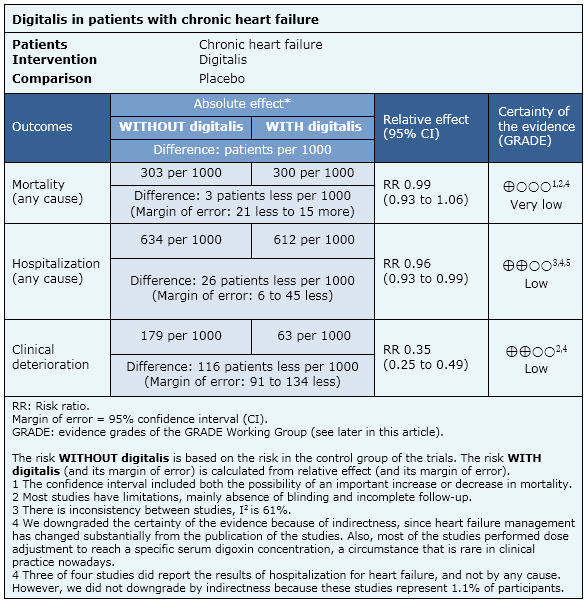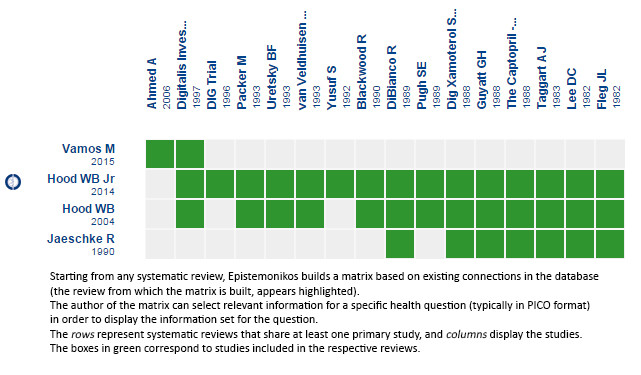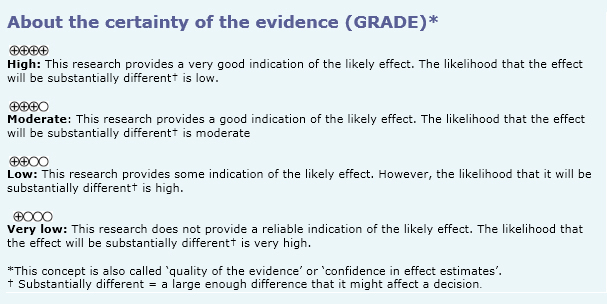Resúmenes Epistemonikos
← vista completaPublicado el 6 de junio de 2015 | http://doi.org/10.5867/medwave.2015.6149
¿Tienen un rol los digitálicos en la insuficiencia cardiaca crónica? - Primera actualización
Is there a role for digitalis in chronic heart failure? - First update
Abstract
This Living FRISBEE (Living FRIendly Summary of the Body of Evidence using Epistemonikos) is an update of the summary published in April 2015, based on a new systematic review published in May 2015.
The main clinical guidelines recommend the use of digitalis for chronic heart failure when moderate to severe symptoms persist after standard therapy, even though there is controversy about its efficacy and security. Searching in Epistemonikos database, which is maintained by screening 30 databases, we identified four systematic reviews including 13 randomized trials. We combined the evidence using meta-analysis and generated a summary of findings table following the GRADE approach. We concluded the use of digitalis for chronic heart failure probably leads to little or no decrease in mortality, but they might reduce hospitalizations and clinical deterioration. However, the certainty of the evidence is low.
About the update
The article updates the April 2015 Living FRISBEE (Living FRISBEE: Living FRIendly Summary of the Body of Evidence using Epistemonikos) (doi: 10.5867/medwave.2015.03.6129) by including one new systematic review appeared after publication of the original article [1].
The new evidence incorporated in this summary led to a downgrade in the certainty of the evidence from low to very low, and the corresponding changes on key messages and considerations for decision-making.
Problem
Digitalis have been in use for treatment of heart failure for more than two centuries. However, their effects on heart failure are controversial. On one hand they would improve symptoms and exercise tolerance. On the other hand they might increase mortality, especially when there is underlying ischemic heart disease, and they carry a high risk of adverse effects.
Methods
We used Epistemonikos database, which is maintained by screening more than 30 databases, to identify systematic reviews and their included primary studies. With this information we generated a structured summary using a pre-established format, which includes key messages, a summary of the body of evidence (presented as an evidence matrix in Epistemonikos), meta-analysis of the total of studies, a summary of findings table following the GRADE approach and a table of other considerations for decision-making.
|
Key messages
|
About the body of evidence for this question
|
What is the evidence. |
We found four systematic reviews [1],[2],[3],[4] including 13 randomized controlled trials that are reported in sixteen articles [5-20]. |
|
What types of patients were included |
All studies considered heart failure of any etiology, being the most frequent ischemic. All studies included patients in sinus rhythm. Only five studies included patients with reduced ejection fraction: < 45% [14],[15], < 40% [5] y and < 35% [17],[18]. One publication reported the outcomes of patients with preserved ejection fraction [20] from the largest trial (DIG). The average age was between 58 to 69 years in the different studies. |
|
What types of interventions were included |
All studies evaluated digoxin, eight using dose adjustments to reach a specific serum level [5],[9],[10],[14],[16-19]. All studies compared against placebo. |
|
What types of outcomes were measured |
Total mortality or heart failure mortality; hospitalization for any cause or for heart failure, emergency room visits, clinical deterioration, quality of life, walking test, neurohumoral markers and echocardiographic parameters. |
Summary of findings
The following information is based on 13 randomized trials that included 9022 patients. Only eight studies reported total mortality. One study reported hospitalization by any cause, four heart failure hospitalization and 12 reported clinical deterioration.
- There is uncertainty if digitalis decrease or increase mortality in chronic heart failure because the certainty of the evidence is very low.
- Digitalis in chronic heart failure might lead to a reduction in hospitalizations and clinical deterioration. The certainty of the evidence is low.

Other considerations for decision-making
|
To whom this evidence does and does not apply |
|
| About the outcomes included in this summary |
|
| Balance between benefits and risks, and certainty of the evidence |
|
| What would patients and their doctors think about this intervention |
|
| Resource considerations |
|
|
Differences between this summary and other sources |
|
| Could this evidence change in the future? |
|
How we conducted this summary
Using automated and collaborative means, we compiled all the relevant evidence for the question of interest and we present it as a matrix of evidence.
 Full size
Full size Follow the link to access the interactive version Digitalis for chronic heart failure

Notes
The upper portion of the matrix of evidence will display a warning of “new evidence” if new systematic reviews are published after the publication of this summary. Even though the project considers the periodical update of these summaries, users are invited to comment in Medwave or to contact the authors through email if they find new evidence and the summary should be updated earlier. After creating an account in Epistemonikos, users will be able to save the matrixes and to receive automated notifications any time new evidence potentially relevant for the question appears.
The details about the methods used to produce these summaries are described here http://dx.doi.org/10.5867/medwave.2014.06.5997.
Epistemonikos foundation is a non-for-profit organization aiming to bring information closer to health decision-makers with technology. Its main development is Epistemonikos database (www.epistemonikos.org).
These summaries follow a rigorous process of internal peer review.
Conflicts of interest
The authors do not have relevant interests to declare.

